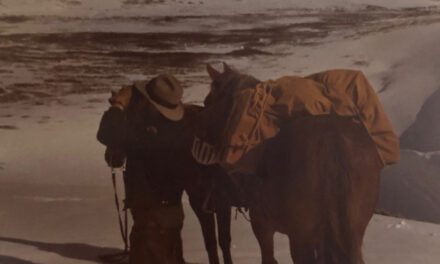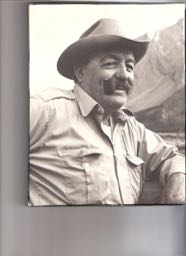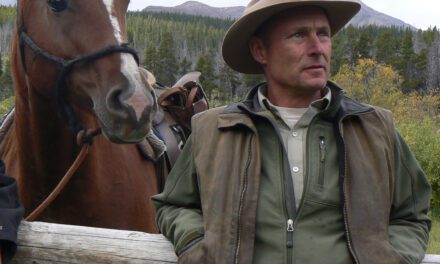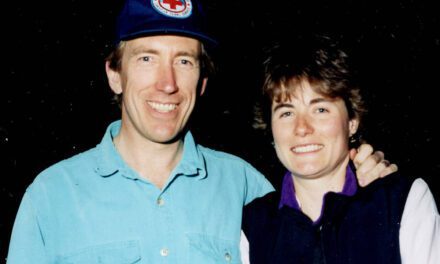Park Warden Alumni Society of Alberta
Oral History Phase 13 Fall 2023
Phone Interview with Al Bjorn
Date/time: November 6, 2023 @ 1000
Interviewed by Monique Hunkeler

Al Bjorn at the 2009 Centennial
Place and date of birth? I was born in 1953 in Montgomery, Alberta
MH: Where did you grow up?
BJ: The place where I was born was just a little town called Montgomery, just west of Calgary. It’s part of Calgary now. I grew up around Shepherd/Ogden area, southeast Calgary.
MH: How did you become involved in the Warden Service? Which National Park did you start working in?
BJ: When I was 19 years old, I had a job as a trail guiding tourists up in Lake Louise on horseback. And I got to see what the wardens did from being there. And also, I met a few of them. And one guy in particular I got to be friends with. His name was Jerry Potts. And he was a native trainee, but we got along pretty good. And from there, I went out on a few horse trips with him just to accompany him and I got thinking this was a pretty good job. And then I decided I’d find out a little more about how I could go about getting on the Warden Service. At that time, you had to go to college or university get a diploma or degree and I ended up enrolling at the Lethbridge Community College for two years to get a diploma in Environmental Sciences. And then I applied at the Warden Service and got on seasonal in 1980. I started working as a warden in Glacier National Park in 1980.
MH: Did you grow up riding horses?
BJ: Yeah, I was riding them since I was a kid. Where we kind of lived in southeast Calgary was along the Bow River and there was an Indian camp down there and they always had horses and we would go down and grab a piece of binder twine get on one and ride them a bit. When I was about 11 or 12 I had a paper route and saved some money and bought a horse and the rest is history.
MH: What made you want to join the Warden Service?
BJ: When I was working up in Lake Louise, I’d seen what the Warden Service did and I found it pretty fascinating that you could actually get a pretty good wage for riding in the backcountry and skiing and mountain climbing and all the kind of adventurous things that a young guy would love to do and get a paycheck for doing it. So I decided this would be the job for me.
MH: What different parks did you work in? How did they compare? Do you have a favourite?
BJ: I started out in Glacier National Park in Rogers Pass and spent some time down in Mount Revelstoke too because it was kind of part and parcel of the park for the first season. And then the following season I went to Elk Island National Park and worked there for I think three seasons as a Seasonal Warden, and then I transferred over to Jasper National Park where I worked for five years there. After Jasper I went up to Kluane National Park for another five years. And then after that I transferred back down to Lake Louise/Banff area. And when Lake Louise joined Kootenay and Yoho National Parks, I was part of that field unit and that’s where I retired. So I got to work in quite a few National Parks.
They’re all unique in their own way, but my most favorite, the wildest and the most spectacular was Kluane National Park because it’s so geographically new. I mean, there are still tons of glaciers and huge mountains and I mean the land is still forming itself. You get surging glaciers, you have rivers that changed direction, you got a lot of stuff and it’s big and it’s wild and some of the highest mountains in Canada. And I think that was one of the most spectacular parks I worked in.
MH: I didn’t know the rivers changed direction?
BJ: Well, when a glacier surges, like, for instance, you got the Casquewats and the Alsek glaciers, or the Lowe Glacier for that matter. And when they surge, sometimes they’ll cut off the natural drainage. And the river will drain the other way. I think it was the Alsek or the Casquewat River surged when I was up there, and the river originally drained into Kluane Lake and then it started draining down into the Alsek River down by Haines Junction. And so that’s a pretty dramatic thing. There’s a lot of water that comes out of there, and for it to change direction or change courses is quite spectacular.
I lived in Destruction Bay, a little town of 25 people when I first started in Kluane National Park. There was another fellow at the station there in Destruction Bay, and that was a Bruce Sundbo. He transferred to Haines Junction and then Kevin McLaughlin came to Destruction Bay, and he stayed for a while, then he transferred to Haines Junction and I was the only one left there. After I left, the Destruction Bay Warden Office closed and everything was stationed out of Haines Junction. But I was fortunate enough to spend my whole time up in the Yukon in Destruction Bay. It was kind of a neat little town and a lot of neat people.
MH: What were some of your main responsibilities over the years?
BJ: I was quite the generalist. I did lots of stuff. I did Law Enforcement, quite a bit of Public Safety when I was in Jasper and even in Lake Louise and in Kluane. That’s what we did in the mountains. A lot of Wildlife Management and high intense Wildlife Management in Elk Island National Park. We used to round the buffalo up every year, and do elk trapping and moose trapping and quite a bit of culling as well, in Elk Island, so it was pretty intense Wildlife Management. And of course, there was quit a Law Enforcement component in Elk Island because it was a small park, totally fenced in, and within close proximity to Edmonton, which has a big population. So, you had a lot of issues with Law Enforcement in that Park. So that was quite active there. And then I worked aquatics, and problem wildlife or human wildlife conflict. And in all the parks pretty much, but particularly in Lake Louise area.
MH: What did you like / Dislike about being a warden?
BJ: For me being a warden, in my career, I liked the diversity of doing lots of different things. And I never really got bored from one day to another because there was always something happening. And that’s when I started but when I ended, we were pretty much stove piped into certain disciplines and we lost that diversity within the Warden Service. But that’s what was really good about my job, for most of my careers, it was the fact that it was very diverse, I did a lot of things.
MH: Dislike? 0900
BJ: Toward the end, it became very political with the arming issue, and just the whole political scene that came about over that issue. And the fact that nobody knew what the heck they were doing any more and we didn’t know where we were going. Then all of a sudden, we weren’t wardens anymore, we were something else. We were either stove piped into a science position or you had to apply to be a Law Enforcement Warden. So, the job that you’ve been doing for your 30-year career, now you had to apply to do it if you wanted to do it, or you were stove piped into different things. And I was particularly stove piped into aquatics. It was a disappointment at the end of my career that the Warden Service had basically left the building and it became something different. And I think it still is that way. We had the good days when we did everything.
MH: What were some of your more memorable events as a Warden?
BJ: I had quite a few good events and bad events but some of the more memorable events were things like summiting Mount Logan in Kluane National Park. That was quite a spectacular event for me. It was in 1992 for the 125th anniversary of Canada, and also the 50th anniversary of the Yukon. It started out with a team of 13 of us to climb Mount Logan and actually measure it, using the technology of the day, which was a new found science called GPS to try to actually measure the mountain. And so it was…that was…about a 32-day expedition to do all this, and managed to summit it and get the proper measurement, which was quite a feat. Because it was a lot of stuff to haul up there. The GPS of that day which wasn’t small, like you could put in a little cell phone now. It was big and clumsy and clunky and and you had to haul up car batteries and keep them warm, and a laptop and all that stuff so you could download stuff and you had to keep it from freezing. So, it was a lot of things that were pretty heavy that we had to haul up to the summit to measure the mountain. That was one of the more memorable moments of my career.
I had bear issues in Jasper that were pretty unique. We had one grizzly bear that was an old boar and his teeth were going on him, so he decided the best way he could survive was breaking into cabins. My district was the Rocky River District and he would go through the district and he would just break into every cabin and basically destroy the whole cabin inside looking for food and smash the cupboards and he’d get into the lard. You would go into the cabin and it would be totally full of bear saliva, flour and spaghetti and he would bite into tin cans of beans and stuff like that and he would rip the whole place apart. And so, we had to go out and snare that bear because he broke into several cabins. And I remember I was with another fella…Darro Stinson…at the time, and we went and that’s when we first noticed that the bear was breaking into cabins. And so, he went to this one cabin where we were staying overnight and the horses were kind of nervous around that cabin. But when we got there, we found out that the bear had got into the cabin through a little window by the stove that was only about two feet by three feet. So, he squeezed in there and he totally ransacked the place and it took us about three hours to clean up all the mess in there. By then it was getting dark and we turned out the horses and got in the bunks and we were sleeping and about three in the morning there was a ruckus on the porch and Darro had his dog with him and the dog was losing it you know; he was just going crazy and the bear was trying to get back into the cabin when we were in there. This cabin is probably only maybe 12X24 size so if a bear did get in there, it wouldn’t have been in a very good thing. It ended up we were in the middle of night trying to get a flashlight going trying to get a rifle and the bear was trying to get in and it became a pretty hairy situation and the dog was going completely nuts. And as the bear was sticking his head in there, we managed to fire a shot and spook him off. And next thing you know we were out in our underwear looking on the porch where the hell that bear went…and then we realized Holy God we were lucky we were alive that that bear didn’t get ahold of us in there. But that was kind of one of the scariest situations working in the backcountry that I encountered.
Anyway, we set snares up and down the district and we finally caught the bear back at Medicine Tent cabin where he had originally broken in. He’d broken into two more cabins, like Karen’s cabin, and another one. And when he came back to the original one where we had that encounter with him, we had set a snare there and caught him. And the word of the day was that this bear is so habituated, we don’t want him in the area at all, so we destroyed him. We shot him right there. But the bear turned out to be an old bear. He was probably in his teenage years and all his canines were gone. And he was just old and couldn’t survive anymore on his own. And that’s probably why he started to raid cabins just to get some food, and but he was about 550 pounds that grizzly bear when we weighed him. That’s quit a big bear. It was pretty exciting at that time.
When we were checking the snares, we rode back, the horses got within about maybe 200 meters and they wouldn’t go any further. They were just not coming in. So, we tied them up there and we got the guns out and walked toward the cabin and where the snare was right beside the cabin, there was a little cubby of trees and we had a bunch of firewood that was stacked there. And I can remember that bear was caught by one front foot and he was just literally going nuts. He was just standing up and he was swinging and he completely set the firewood just flying all over the place, and he debarked a tree from eight feet high straight down. And you could just see him standing up on his hind legs with his front leg caught and you could just see the muscle rippled in that bear. That bear had so much power, that it just scared you to be anywhere near that bear. It was quite spectacular how much power those things have. And then it was a bittersweet deal when we shot him. Although the bear had to be destroyed, we were pretty sad to have to destroy something that beautiful, but it had to be done.
MH: Can you tell me about any rescue/wildlife stories that stick out in your memory?
BJ: I remember bear 56 had a couple of cubs when I was working in Lake Louise. She was totally a docile grizzly bear and would walk around town and stuff like that. And I remember, this was before she had her cubs, I think this was her first heat. She was a four or five-year-old and the time and she went into heat and this big male was following her and she didn’t want no part of this big male grizzly bear. She was more comfortable with people than she was with another bear. And she tried to dodge that bear any way she could. And I remember her just walking on the Chateau Lake Louise Road, walking in and out along the Louise Creek Trail and along the road, and back and forth with this big boar behind her chasing her around. And there were people scurrying everywhere and it was crazy and we thought “Oh boy, this is gonna be a wreck somewhere”. She went right into the campground at Lake Louise from Louise Creek with this boar on the tail. And I remember her seeing me in my truck because she could recognize my truck because we had hazed her so many times. She came right toward my truck so that the boar who was chasing her would get scared and take off. Basically, she was looking for salvation anyway she could to get rid of this big bear. But she ended up getting bred and then she had three little cubs. And because of her nature, she dragged these cubs into the townsite of Lake Louise and the high visitor use areas all around the Lake Louise. We had to tranquilize her and then we had to catch the cubs and I remember catching those cubs and carrying them over where we had her tranquilized and we caught her in a trap and then we had the snare these cubs and tranquilize these little guys. And it was quite hilarious to pack a cub on your shoulder to bring the little cub grizzly bear back to his mom. That was one of the bear experiences I had.
MH: Were they trying to bite you or anything? 1953
BJ: They were like Velcro. They would just cling on to you and they were tranquilized so we could carry them but they didn’t try to bite they were out. But it was just the fact that we had to pack them around back to the mother kind of interesting deal.
And another bear incident we had where we actually had to steer the cubs without tranquilization, occurred up at the summit between Banff National Park and Yoho National Park, a railway siding called Summit Lake, and that’s where the grain trains would park before they had to descend down the Big Hill to go to Field. And where the grain trains parked, there was always a leakage of grain and so there was always bears around trying to get grain from the grain cars, and so the cubs climbed right up on the inside where the cars hooked up together. And then there was a little cubby hole where the cubs kind of hid while the mother would eat grain; and the little cubs would jump up with her. And then when the train started to move, the mother would jump off and the little ones would get scared and they’d climb in this little kind of round hole and just hide there and then the train would go. And so, the only way we noticed was one of the train people down in Field noticed that there were little cubs at the end of one of the grain cars, so we would get called. And we had to get these little buggers out of that little hole and then put them in little dog cages and take them back to where the mother was so, hopefully they could reunite. We used one of those long poles that had a little tether loop that you catch dogs with to catch the little buggers. And then you’d have to pull them out of that little hole and they would just be like Velcro, they’d cling to you and they’d try to climb on you. And then you try to get them into a little dog cage so we could move them in a truck. So, it was quite comical trying to get these little buggers back to their mother. Anyway, so we finally did get that all done. And then she did it again. And she lost her cubs again. And we had to do the same thing. And finally, she did it again and the cubs disappeared. I think that they ended up staying there and the train kept going to Vancouver they probably were at Vancouver terminal by the time somebody noticed that they were in there. It was kind of a unique thing, catching those cubs with that tether pole.
22:47
I remember one time; this is one of the rescues that was pretty sad deal. It was in March and it was about 5:30 in the evening and I was working at Sunwapta Warden Station at the time. I was heading back to the station from the Columbia Icefields and I get this call from one of the Icefields Visitor Center people that there was somebody who had fallen in a crevasse on Athabasca Glacier. And so, we had to get going. There were four doctors that were touring up on the top of the Columbia Icefields and they were coming down the icefield ramp, about the third icefall coming down off of Athabasca Glacier. And they weren’t roped up and one fell in and the other three got down and reported it. So, by the time we got things organized, it was just about dark and we managed to fly in. And then we set up a rescue retrieval rope system. There was about six of us on the rescue, and managed to lower one guy down and he found the person and the person was dead already. He had basically frozen to death or died of hypothermia down in the bottom of a crevasse and we end up hauling him back up in the middle of the night. We didn’t get him out until about one in the morning. The rescue had to happen so fast that we didn’t get a chance to get our camping gear in so we had a bivvy (bivouac) sack and all of us were kind of cuddled up all night with his dead guy using whatever he had, a bivvy sack and a sleeping bag which we used to stay warm until the helicopter in the morning could come and get us. And it was one of the coldest, most miserable nights of my life I’ve ever spent out on a glacier. Everybody was just freezing. But it was sure nice to see that helicopter in the morning. Anyway they slung the dead guy out and we all got slung out. So it was quite a harrowing experience that night. We had to do everything by moonlight and flashlight. It was such a quick response with such a limited amount of daylight left for the helicopter to get us up there. So that was another one of those memorable moments.
One of the funnier moments I had when I was working, it was either Lise or you or someone else who was dispatching at the time, but I got a call that there was a bear jam at Herbert Lake. And this was in the summertime, I think August, and it was one of the hotter days of the whole summer. So, I headed up there and there was a whole bunch of people right at the lake shore along the road. And I went up and down and I didn’t see any bear but I see a whole bunch of girls with their tops off sunbathing. And so I radioed back and I said “There’s no bear jam here but I think there’s a boob jam”. Probably just about every staff member from Lake Louise who wasn’t working, was there Herbert Lake that day just having a kind of beach party. There were a lot of neat moments in my career.




the paragraph that starts with ” anyway we set snare’s up ” the correct spelling is Cairn cabin not Karin cabin thanks